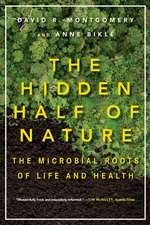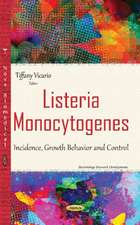Planctomycetes: Cell Structure, Origins and Biology
Editat de John A. Fuersten Limba Engleză Paperback – 9 aug 2015
| Toate formatele și edițiile | Preț | Express |
|---|---|---|
| Paperback (1) | 691.41 lei 6-8 săpt. | |
| Humana Press Inc. – 9 aug 2015 | 691.41 lei 6-8 săpt. | |
| Hardback (1) | 948.92 lei 6-8 săpt. | |
| Humana Press Inc. – 20 iul 2013 | 948.92 lei 6-8 săpt. |
Preț: 691.41 lei
Preț vechi: 813.42 lei
-15% Nou
Puncte Express: 1037
Preț estimativ în valută:
132.32€ • 137.63$ • 109.24£
132.32€ • 137.63$ • 109.24£
Carte tipărită la comandă
Livrare economică 14-28 aprilie
Preluare comenzi: 021 569.72.76
Specificații
ISBN-13: 9781627039406
ISBN-10: 1627039406
Pagini: 286
Ilustrații: XII, 286 p.
Dimensiuni: 155 x 235 x 16 mm
Greutate: 0.42 kg
Ediția:Softcover reprint of the original 1st ed. 2013
Editura: Humana Press Inc.
Colecția Humana
Locul publicării:Totowa, NJ, United States
ISBN-10: 1627039406
Pagini: 286
Ilustrații: XII, 286 p.
Dimensiuni: 155 x 235 x 16 mm
Greutate: 0.42 kg
Ediția:Softcover reprint of the original 1st ed. 2013
Editura: Humana Press Inc.
Colecția Humana
Locul publicării:Totowa, NJ, United States
Cuprins
History, Classification and Cultivation of the Planctomycetes.- Cell Compartmentalization and Endocytosis in Planctomycetes: Structure and Function in Complex Bacteria.- Structural Aspects of MC Proteins of PVC Superphylum Members.- Cell Biology of Anaerobic Ammonium Oxidizing Bacteria:Unique Prokaryotes with an Energy Conserving Intracellular Compartment.- Acidophilic Planctomycetes: Expanding the Horizons of New Planctomycete Diversity.- Towards the Development of Genetic Tools for Planctomycetes.- Genomics and Bioinformatics of the PVC Superphylum.- The Distribution and Evolution of C1 Transfer Enzymes and Evolution of the Planctomycetes.- Unusual Members of the PVC Superphylum: The Methanotrophic Verrucomicrobia Genus “Methylacidiphilum”.- Phyla Related to Planctomycetes: Members of Phylum Chlamydiae and their Implications for Planctomycetes Cell Biology.- Planctomycetes – their Evolutionary Implications for Models of the Origins of Eukaryotes and the Eukaryote Nucleus.- A Final Word - The Future of Planctomycetology and Related Studies.
Textul de pe ultima copertă
Planctomycetes, and their relatives within the PVC superphylum of domain Bacteria, including verrucomicrobia and chlamydia, challenge our classical concept of the bacterium and its modes of life and provide new experimental models for exploring evolutionary cell biology and the full diversity of how living cells can be organized internally. Unique among Bacteria they include species possessing cells with intracellular membrane-bounded compartments and a peptidoglycan-less cell wall, and bacteria such as the anammox organisms performing unique anaerobic ammonium oxidation significant for global nitrogen cycle. The book introduces these fascinating and important bacteria and deals in detail with their unusual structure, physiology, genomics and evolutionary significance. It is a definitive summary of our recent knowledge of this important distinctive group of bacteria, microorganisms which challenge our very concept of the bacterium.
Caracteristici
Focuses on the cell biology of planctomycetes Provides details on the significant ecology and enviromental significance of planctomycetes Examines planctomycetes' unusual structure, physiology, genomics and evolutionary significance Includes supplementary material: sn.pub/extras









